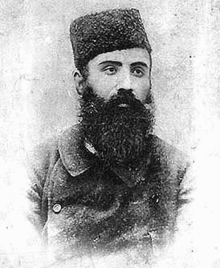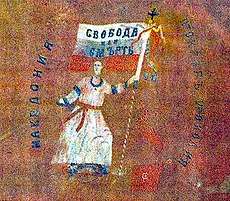Hristo Uzunov
Hristo Dimitrov Uzunov (Bulgarian and Macedonian: Христо Димитров Узунов) (22 February 1878, Ohrid – 24 April 1905, Cer, near Kičevo) was a Bulgarian teacher[1] and revolutionary,[2] head of the Ohrid branch of the Internal Macedonian Revolutionary Organization and its ideological leader in the Ohrid region.[3][4] Despite his Bulgarian self-identification,[5][6] according to the post-WWII Macedonian historiography,[7] he was an ethnic Macedonian.[8]
Hristo Uzunov Христо Узунов | |
|---|---|
 Portrait of Hristo Uzunov | |
| Born | February 22, 1878 Ohrid, Ottoman Empire (now Republic of North Macedonia) |
| Died | April 24, 1905 (aged 27) Cer, Ottoman Empire (now Republic of North Macedonia) |
| Other names | Dule Uzunov |
| Organization | Voevoda of the Bulgarian Macedonian-Adrianople Revolutionary Committees, (later SMORO, IMORO, IMRO) |
Revolutionary life

Hristo Uzunov was born in 1878 in Ohrid, then in Ottoman Empire. Both his father and mother were active in the Bulgarian national movement. After the establishment of the Principality of Bulgaria his father settled in Sofia and worked here as a librarian in the National Library. It is believed that Uzunov became a member of the revolutionary movement in 1896, while he studied in Bulgarian Men's High School of Thessaloniki. Afterward he worked as Bulgarian Exarchate's teacher.[11] On August 5, 1898, Dimitar Grdanov, a Serbian teacher in Ohrid, and pro-Serbian activist in Macedonia, was murdered by Metody Patchev, after which Patchev and his fellow conspirators Hristo Uzunov, Cyril Parlichev and Ivan Grupchev were arrested.[12] Between January 1902 and March 1903 he was re-imprisoned in the Bitola jail. He actively took part in the Ilinden Uprising in 1903. After the Bulgarian Army officer Toma Davidov was killed by the Turks in March 1903, Uzunov took over the leadership of the revolutionary organization in Ohrid area.[13] On July 23, 1903, in the village of Kuratica, near Ohrid, the flag of Uzunov's cheta was consecrated. The flag was handed over to Uzunov and with it the regional cheta was active during the Ilinden Uprising.[14] Between 1904 and 1905 he focused at resisting the Serbian guerrilla campaigns in Macedonia[15] and tried to resolve of the organization's internal problems.
Death
In 1905 Uzunov with his band (cheta) entered Bitola and after that Kičevo in order to gain control of that region. On 23 April 1905, they entered the village of Tser in the region of Kičevo, together with the cheta of Kičevo voivode Vancho Sarbakov. On the night of April 24, they were surrounded by a great number of Ottoman forces and after using up their ammunition, facing surrender, they decided to commit suicide.[16] Uzunov then wrote a short letter addressed to all "honourable revolutionaries" and after that he and his men killed themselves. His grave is located in Tser, where he died.
References
- In Macedonia, the education race produced the Internal Macedonian Revolutionary Organization (IMRO), which organized and carried out the Ilinden Uprising of 1903. Most of IMRO’s founders and principal organizers were graduates of the Bulgarian Exarchate schools in Macedonia, who had become teachers and inspectors in the same system that had educated them. Frustrated with the pace of change, they organized and networked to develop their movement throughout the Bulgarian school system that employed them. The Exarchate schools were an ideal forum in which to propagate their cause, and the leading members were able to circulate to different posts, to spread the word, and to build up supplies and stores for the anticipated uprising. As it became more powerful, IMRO was able to impress upon the Exarchate its wishes for teacher and inspector appointments in Macedonia. For more see: Julian Brooks, The Education Race for Macedonia, 1878—1903 in The Journal of Modern Hellenism, Vol 31 (2015) pp. 23-58.
- The revolutionary committee dedicated itself to fight for "full political autonomy for Macedonia and Adrianople." Since they sought autonomy only for those areas inhabited by Bulgarians, they denied other nationalities membership in IMRO. According to Article 3 of the statutes, "any Bulgarian could become a member". For more see: Laura Beth Sherman, Fires on the mountain: the Macedonian revolutionary movement and the kidnapping of Ellen Stone, Volume 62, East European Monographs, 1980, ISBN 0914710559, p. 10.
- Радев, Симеон. Ранни спомени, Български писател, 1969, стр. 316.
- Трагичната участ на Узунова и четата му, Тома Николов, Отеч. фронт, София, 1989, гл. 16.
- Дневник на Христо Узунов (Memoires from Hristo Uzunov. The original was wrritten in Bulgarian. The notes were made immediately after the Ilinden uprising for much of the winter of 1903, when Uzunov resided in Ohrid as illegal. In short, in chronological order, it traces the history of the Ohrid Revolutionary Organization from its inception in 1894 to the suppression of the uprising. Uzunov probably intended to write a story about the revolutionary movement in Ohrid. Some of the names and facts in the notebook are given with a cipher. They are decrypted by the voivode's brother - Angel Uzunov. All the pages in the notebook are not listed (p. 2, 6—94, 109, 115, 121—124, 130, 136—139). Table 2 consists of a list of killed Bulgarians (only) in Ohrid and Struga areas on suspicion of being IMRO activists.), в: "Дневници и спомени за Илинденско-Преображенското въстание", Издателство на Отечествения фронт, София, 1984, стр.83-147.
- Николов, Борис, Непубликувани документи из архива на Христо Узунов, сп. Исторически преглед, кн. 5, София, 1990, с. 81–91; Nikolov, Boris, Unpublished Documents from the Archive of Hristo Uzunov, Historical Review Magazine, Vol. 5, Sofia, 1990, pp. 81–91(in Bulgarian)
- Victor Roudometof, Collective Memory, National Identity, and Ethnic Conflict: Greece, Bulgaria, and the Macedonian Question, Greenwood Publishing Group, 2002 ISBN 0275976483, p. 58.
- The first name of the IMRO was "Bulgarian Macedonian-Adrianople Revolutionary Committees", which was later changed several times. Initially its membership was restricted only for Bulgarians. It was active not only in Macedonia but also in Thrace (the Vilayet of Adrianople). Since its early name emphasized the Bulgarian nature of the organization by linking the inhabitants of Thrace and Macedonia to Bulgaria, these facts are still difficult to be explained from the Macedonian historiography. They suggest that IMRO revolutionaries in the Ottoman period did not differentiate between ‘Macedonians’ and ‘Bulgarians’. Moreover, as their own writings attest, they often saw themselves and their compatriots as ‘Bulgarians’ and wrote in Bulgarian standard language. For more see: Brunnbauer, Ulf (2004) Historiography, Myths and the Nation in the Republic of Macedonia. In: Brunnbauer, Ulf, (ed.) (Re)Writing History. Historiography in Southeast Europe after Socialism. Studies on South East Europe, vol. 4. LIT, Münster, pp. 165-200 ISBN 382587365X.
- National military history museum of Bulgaria, fond 260
- Илиев, Ив. Свети бойни реликви. — Военноисторически сборник, 1983, № 3, е. стр. 207—209.
- Historical Dictionary of the Republic of Macedonia, Dimitar Bechev, Scarecrow Press, 2009, ISBN 0810855658, p. 230.
- Makedonija (501-512 ed.). 1995. p. 30.
- Николов, Борис Й. Вътрешна македоно-одринска революционна организация. Войводи и ръководители (1893 – 1934). Биографично-библиографски справочник, София, 2001, стр. 40.
- Иванов Иван, Знамената на освободителното движение и въстанията в Македония и Тракия (откъс от "Български бойни знамена и флагове") Издателство на Министерство на отбраната "Св. Георги Победоносец", 1998.
- Николов, Тома. "Спомени от моето минало", Издателство на Отечествения фронт, София, 1989
- Трагичната участ на Узунова и четата му, Тома Николов, Отеч. фронт, София, 1989.